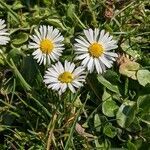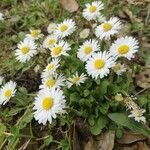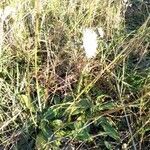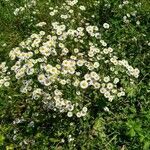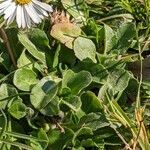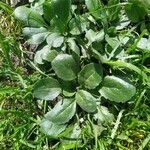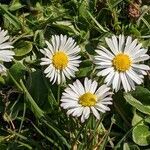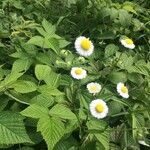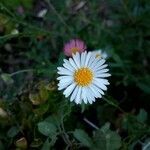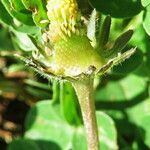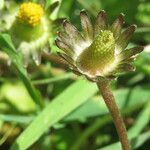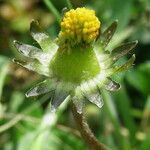Herbs, perennial or annual, scapose, 10-25 cm tall; scape sparsely villosulous, strigose, sparsely, minutely stipitate glandular distally (near capitulum). Leaves basal, rosulate, petiole long, winged, blade spatulate, 2-6 × 0.9-2.8 cm, base attenuate, margin serrate to crenate, apex obtuse, sometimes retuse, mucronulate. Capitula terminal, solitary. Involucre hemispheric or broadly campanulate, 5-6 mm; phyllaries 2-seriate, subequal, oblanceolate, leaflike, surfaces sparsely villous, margin narrowly scarious, sparsely ciliate, midvein thin, translucent, apex obtuse, scarious, ciliate. Ray florets white or pinkish, lamina ca. 10 × 1 mm; disk florets yellow, ca. 2 mm, limb campanulate, ca. 1.5 mm, sparsely hairy proximally, lobes erect, triangular, ca. 0.5 mm, eglandular. Achenes strigillose. Pappus absent.
Fibrous-rooted, scapose perennial, ± spreading-hairy; lf-blades elliptic or ovate to orbicular, dentate or denticulate, to 4 × 2 cm, narrowed to a margined petiole of equal or greater length; scape 5–15 cm; disk 5–10 mm wide; rays numerous, white to pink, to 1 cm; 2n=18. A weed in lawns and waste places, intr. from n. Europe and ± established throughout n. U.S. Apr.–Nov.
A perennial herb. It only lives for a short time. They can be grown as annuals. It grows 5-20 cm high and wide. The leaves are in rosettes or rings. They are rounded at the ends and taper into the stalk. The flower stem is short and the flower heads have yellow centres surrounded by white ray florets. These can be pink or red. The flowers are 2.5-5 cm across.
Rhizomes short, erect, herbaceous. Leaves: petioles winged, equaling or longer than blades; blades 6–40 × 4–20 mm, bases ± attenuate, apices rounded. Peduncles lax, (3–)5–15(–20) cm. Phyllaries: margins ciliolate, particularly distally, apices obtuse. Ray corollas 4–8(–11) mm. Disc corollas 1.5 mm. Cypselae 1–2 mm. 2n = 18.
